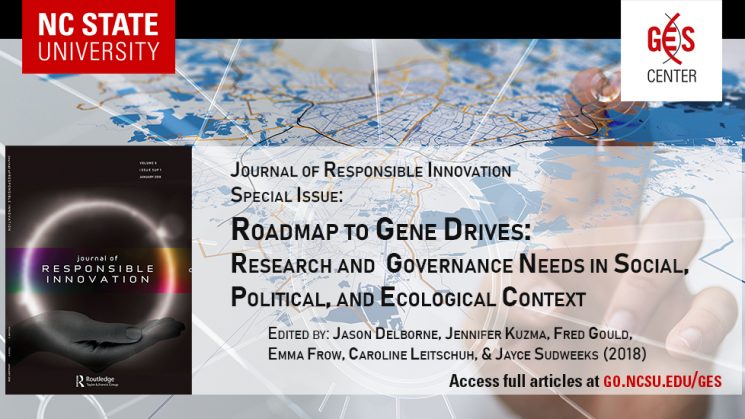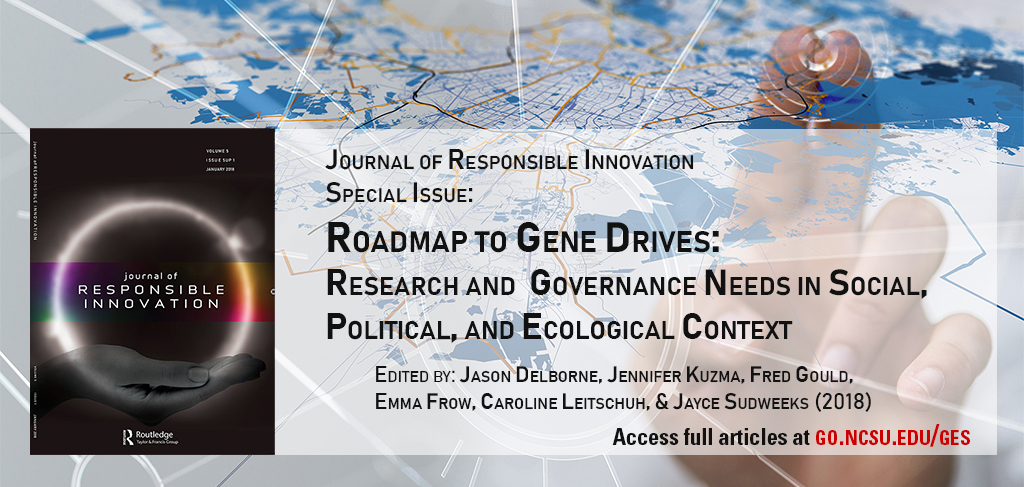
The Genetic Engineering and Society Center at NC State hosted a workshop in February of 2016, supported in part by the National Science Foundation, entitled ‘A Roadmap to Gene Drives: A Deliberative Workshop to Develop Frameworks for Research and Governance.’ (see workshop site)
 In order to examine core governance issues and research needs in an anticipatory way, this three-day workshop brought together over 70 subject matter experts from academia, business, government, and non-profit organizations from 10 different countries in Europe, Australia, and North and South America.
In order to examine core governance issues and research needs in an anticipatory way, this three-day workshop brought together over 70 subject matter experts from academia, business, government, and non-profit organizations from 10 different countries in Europe, Australia, and North and South America.
Those experts were invited to submit papers for this special issue of the Journal of Responsible Innovation. In total, 13 peer reviewed papers are included in the special Gene Drive issue of the Journal. The editorial team included three NC State faculty and two GES PhD students.
Adapted from the Introduction: “Mapping research and governance needs for gene drives“
What is a gene drive?
A gene drive is a mechanism that biases inheritance of a trait in a sexually reproducing species of organisms. In this context, “bias” means to increase the odds of a parent passing on a portion of their DNA to above 50%, or what is historically understood as Mendelian inheritance (remember the wrinkled pea experiments?). In fact, under laboratory conditions, some gene drives have been shown to function at 95% efficiency or higher, meaning that a parent carrying a genetic sequence associated with a gene drive will pass on that sequence nearly every time that they reproduce. The key takeaway is that designed gene drives could theoretically allow humans to “drive” a desired trait into a population of organisms. Importantly, this population could be wild – neither its habitat nor its breeding behavior need be under human control – and the desired trait might reduce the fitness of the organism even while increasing in frequency throughout the population.
Why all the attention to gene drives?
While it has not quite become a household term, there has been significant attention to this emerging field of research in the popular and scientific media. On one hand, this should come as no surprise given the anticipated potential for gene drives to address intractable problems in public health, agriculture, and conservation. The close association between recent advances in gene editing (e.g., CRISPR) and gene drives likely also contributes to its newsworthiness. And perhaps there is some additional excitement seeing biotechnology cautiously embraced by public health advocates and biodiversity conservation NGOs. Of equal importance, while laboratory proofs of concept are accumulating slowly – increasing confidence that humans can construct gene drives with a purpose – no one yet knows if they really work. As of the close of 2017, no gene drive modified organism has been released outside of the laboratory.
What is behind this special issue?
In January 2015, faculty from North Carolina State University’s Genetic Engineering and Society Center submitted a workshop proposal to the National Science Foundation’s Science, Technology, and Society (STS) program entitled, “Gene Drives: A Deliberative Workshop to Develop Frameworks for Research and Governance.” The proposal noted that “[r]ecent legal and policy scholarship has focused on the need for governance to ‘keep pace’ with technological innovation in multiple domains, including biotechnology. However, we currently lack a broad evaluation of the potential ecological, political economy, ethical, and other issues to guide research and development of gene drives.” The workshop was envisioned to contribute to filling this gap, and its February 2016 agenda included presentations from diverse experts, ranging from molecular biologists to public policy scholars. Those experts and other attendees were invited to submit papers to this special issue, which were peer reviewed by a mixture of workshop attendees and other scholars.
What is inside this special issue?
This special issue represents both deep and broad thinking about gene drives. It is not a roadmap in a typical sense, such as a Google map, whose utility is marked by comprehensive integration of ground-truthed facts and perfect clarity in departure points and destinations. Instead, the articles provide signposts that encourage attention to diverse issues, remind readers of helpful frameworks and analogies, and foster interdisciplinary conversations about the pursuit of responsible innovation in gene drive research and development.
Acknowledgements
The editors would first like to thank the contributors to this special issue, who offered their expertise, creativity, time, and energy to create a truly interdisciplinary analysis of the emerging field of gene drive research. We also thank all those who attended the gene drive workshop at North Carolina State University in 2016, whose ideas helped inspire the papers that follow. Erik Fisher, Editor-in-Chief of the Journal of Responsible Innovation, provided thoughtful guidance and support at every step of the publication process. We also acknowledge the many scholars who offered their expert judgments and constructive criticisms of manuscript drafts as part of the invisible labor of peer-review. Finally, support from the staff at the Genetic Engineering and Society Center, including Sharon Stauffer and Patti Mulligan, make projects like this possible, impactful, and more enjoyable.
Papers
Journal of Responsible Innovation | Roadmap to Gene Drives: Research and Governance Needs in Social, Political, and Ecological Context |
Gene drives and the expanding horizon of governance
|
Mapping research and governance needs for gene drives
|
A roadmap for gene drives: using institutional analysis and development to frame research needs and governance in a systems context
|
Harnessing gene drive
|
Gene drive to reduce malaria transmission in sub-Saharan Africa
|
Anticipating complexity in the deployment of gene drive insects in agriculture
|
Agricultural production: assessment of the potential use of Cas9-mediated gene drive systems for agricultural pest control
|
Developing gene drive technologies to eradicate invasive rodents from islands
|
Identifying and detecting potentially adverse ecological outcomes associated with the release of gene-drive modified organisms
|
The roles of ethics in gene-drive research and governance
|
Economic issues to consider for gene drives
|
Regulating animals with gene drive systems: Lessons from the regulatory assessment of a genetically engineered mosquito
|
Anomaly handling and the politics of gene drives
|
Gene drives and the management of agricultural pests
|
Committee on Gene Drive Research in Non-Human Organisms: Recommendations for Responsible ConductSummary of Consensus Report, Gene Drives on the Horizon: Advancing Science, Navigating Uncertainty, and Aligning Research with Public Values (2016). Washington, DC: The National Academies Press. doi: 10.17226/23405. Download |
